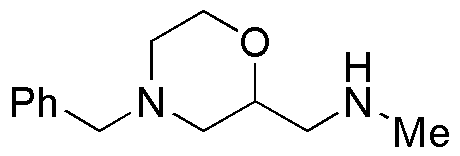(4-Benzyl-morpholin-2-ylmethyl)methylamine is widely utilized in research focused on
- Pharmaceutical Development: This compound serves as a building block in the synthesis of various pharmaceuticals, particularly in creating drugs targeting neurological disorders due to its morpholine structure.
- Biochemical Research: It is used in studies involving enzyme inhibition and receptor binding, providing insights into drug interactions and biological pathways.
- Material Science: The compound can be incorporated into polymer formulations, enhancing properties such as flexibility and durability, which is beneficial for developing advanced materials.
- Agricultural Chemistry: It is explored as a potential agent in agrochemicals, helping to develop more effective pesticides or herbicides that target specific pests while minimizing environmental impact.
- Cosmetic Formulations: Due to its unique chemical properties, it is being investigated for use in cosmetic products, particularly as a stabilizer or emulsifier in creams and lotions.
General Information
Properties
Safety and Regulations
Applications
(4-Benzyl-morpholin-2-ylmethyl)methylamine is widely utilized in research focused on
- Pharmaceutical Development: This compound serves as a building block in the synthesis of various pharmaceuticals, particularly in creating drugs targeting neurological disorders due to its morpholine structure.
- Biochemical Research: It is used in studies involving enzyme inhibition and receptor binding, providing insights into drug interactions and biological pathways.
- Material Science: The compound can be incorporated into polymer formulations, enhancing properties such as flexibility and durability, which is beneficial for developing advanced materials.
- Agricultural Chemistry: It is explored as a potential agent in agrochemicals, helping to develop more effective pesticides or herbicides that target specific pests while minimizing environmental impact.
- Cosmetic Formulations: Due to its unique chemical properties, it is being investigated for use in cosmetic products, particularly as a stabilizer or emulsifier in creams and lotions.
Documents
Safety Data Sheets (SDS)
The SDS provides comprehensive safety information on handling, storage, and disposal of the product.
Product Specification (PS)
The PS provides a comprehensive breakdown of the product’s properties, including chemical composition, physical state, purity, and storage requirements. It also details acceptable quality ranges and the product's intended applications.
Certificates of Analysis (COA)
Search for Certificates of Analysis (COA) by entering the products Lot Number. Lot and Batch Numbers can be found on a product’s label following the words ‘Lot’ or ‘Batch’.
*Catalog Number
*Lot Number
Certificates Of Origin (COO)
This COO confirms the country where the product was manufactured, and also details the materials and components used in it and whether it is derived from natural, synthetic, or other specific sources. This certificate may be required for customs, trade, and regulatory compliance.
*Catalog Number
*Lot Number
Safety Data Sheets (SDS)
The SDS provides comprehensive safety information on handling, storage, and disposal of the product.
DownloadProduct Specification (PS)
The PS provides a comprehensive breakdown of the product’s properties, including chemical composition, physical state, purity, and storage requirements. It also details acceptable quality ranges and the product's intended applications.
DownloadCertificates of Analysis (COA)
Search for Certificates of Analysis (COA) by entering the products Lot Number. Lot and Batch Numbers can be found on a product’s label following the words ‘Lot’ or ‘Batch’.
*Catalog Number
*Lot Number
Certificates Of Origin (COO)
This COO confirms the country where the product was manufactured, and also details the materials and components used in it and whether it is derived from natural, synthetic, or other specific sources. This certificate may be required for customs, trade, and regulatory compliance.

